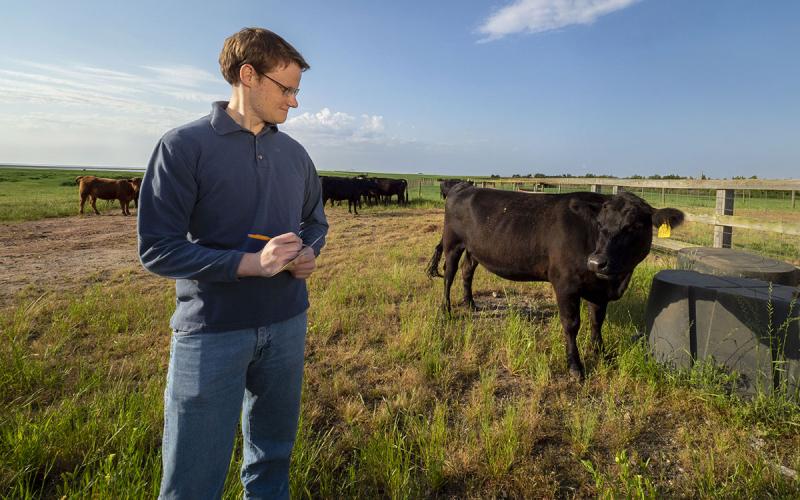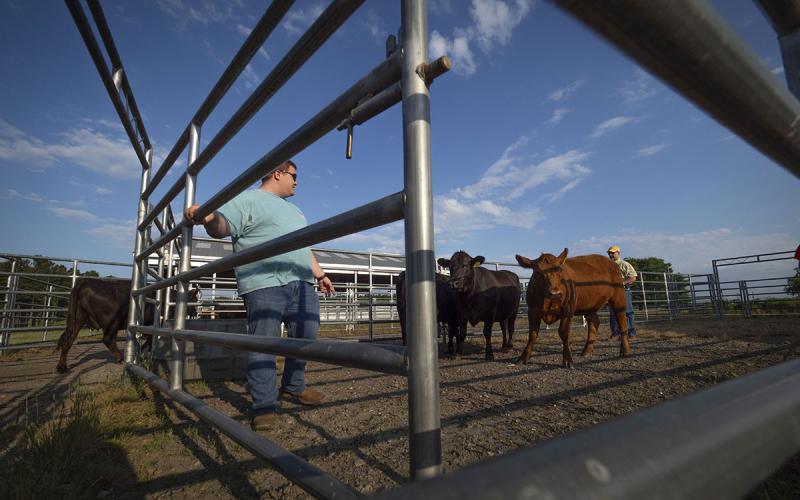Written by Addie Stamps, former SDSU Extension Livestock Production and Stewardship Field Specialist.
Just like with tractors, combines and trucks, when a company releases a new chute design or cattle working facility, we want an upgrade. But the hot new item isn’t always the best fit for your operation. There is research continually being done to better understand cattle behaviors and develop working facilities that work with them. I’m going to cover some basic aspects of cattle working facilities so that information can be pieced together to make a system that best fits your operation.
Cattle Design Tips

Understand Your Animals
Take the time to read over articles and watch videos that dive into cattle behaviors. Understanding how cattle perceive the world and how their natural instincts affect their behavior will guide you into proper facility design to work with the animals instead of against them. No matter the situation, cattle are going to want to remove pressure, make sure they have a clear path through working facilities to do that.
High- and Low-Pressure Areas
High-pressure areas are also known as high traffic areas. These are areas where cattle are funneled into more confined spaces. Low-pressure areas are where cattle are not being asked to move, like in a holding pen. It’s crucial you understand the two design facilities so that movement flows well through the high-pressure areas.
Size Matters
The size of your operation and size of cattle will affect facility designs. The size of your operation directly affects the amount of pressure your facilities undergo. If you are routinely working cattle, there is more of a need for high quality equipment. On the other hand, if you have a smaller herd or aren’t working cattle as frequently there are corral panels that could be used or portable systems. If your operation is based on calves or yearlings, you will need the proper size equipment. While if you are running a feedyard, with animals at market weight you will need larger equipment.
Gate Placement
Successful cattle working systems are dependent on proper gates. A good rule of thumb is to add more gates than you think are necessary. It is easier to just leave one open than it is to later adapt a system to add a gate.
Design Flow
Reiterating that not every system will work properly with your cattle, location and your goals. Building a brand-new working facility is a once in a career experience for many producers. More frequently we’re making adaptations to existing facilities, whether that be working with the barn that’s already there or preexisting alleys and pens. Design a system that will flow well with what you already have and with cattle behaviors. Especially making sure there is good flow for cattle in and out of the working facility as well as in other high-pressure areas.
Components

Location
You want to choose a location for your main working facilities that is easily accessible from pastures but also close enough to a main road for efficient loading and unloading. Avoid placing facilities at the bottom of a slope or in flood-prone areas. Having the site on a slight incline allows for better drainage, and accessibility year-round is key — especially during wet or snowy seasons. Also consider wind direction and sun exposure, as working in a comfortable environment benefits both people and cattle. Beaming sunlight affects cattle vision, so keep that in mind when designing entry and exit points.
Measurement
Precision in measurement is one of the most overlooked elements in cattle working systems. Alley widths, chute lengths, and pen capacities should reflect the size of the cattle you are handling. Alleys should be wide enough to allow forward movement but narrow enough to discourage turning. Sweep tubs and crowding alleys should allow for gradual, curved movement, not tight corners that cause stress or stoppage. Always reference trusted industry guidelines or extension resources for standard facility dimensions.
Panels
Panels come in a wide range of styles, strengths, and price points. For temporary or small operations, lighter panels may be enough, but for high-traffic or permanent setups, heavy-duty panels are worth the investment. Look for solid-sided options in crowding areas to reduce distractions and keep cattle focused on moving forward. Also check how panels connect — secure, easy-to-use latches can save time and prevent injuries.
Holding Pens
Holding pens are where cattle should feel calm before being moved into the working area. Overcrowding is a recipe for stress and injury. A good rule is about 20–25 square feet per head for mature cattle. Design holding pens with wide openings, clear sightlines, and access to water if animals are held for extended periods. Multiple pens allow for sorting and staging, which improves flow and helps keep groups separated based on pen, size, or purpose.
Alleys
Alleyways are the arteries of your system. Straight alleys provide a clear path for cattle to follow, but curved alleys utilize cattle's natural tendency to circle back to where they came from and reduce distance humans have to work. Alleys should be long enough to hold multiple animals without backing them into each other, but short enough to prevent hesitation. Non-slip flooring and solid sides help maintain movement and safety. Consider adding catwalks or access gates for handler convenience.
Chute
The chute is where precision and safety matter most. Whether you're doctoring, tagging, breeding, or pregnancy checking, you need a chute that restrains cattle firmly without causing injury. Hydraulic chutes offer ease and speed for large operations, while manual chutes are more affordable and effective for smaller herds. Features like adjustable width, head gates, and palpation cages can make a huge difference in worker efficiency and cattle comfort.
Additional Components
There are dozens of add-ons and modifications to consider, depending on your specific needs. These include scales for monitoring weight, loading ramps for transport, water access in pens, shade structures, and lighting for early morning or late-night work. While not always necessary up front, planning your layout to accommodate these components down the line can save time and money later.
In Summary
Again, not every system works perfectly for every operation. However, when you understand the components that make up cattle working systems, and natural cattle behaviors, you can piece them to develop a something that works well.


